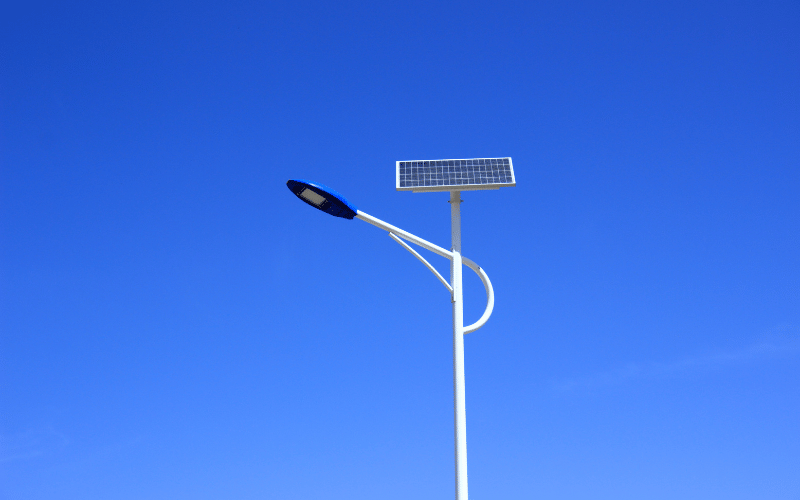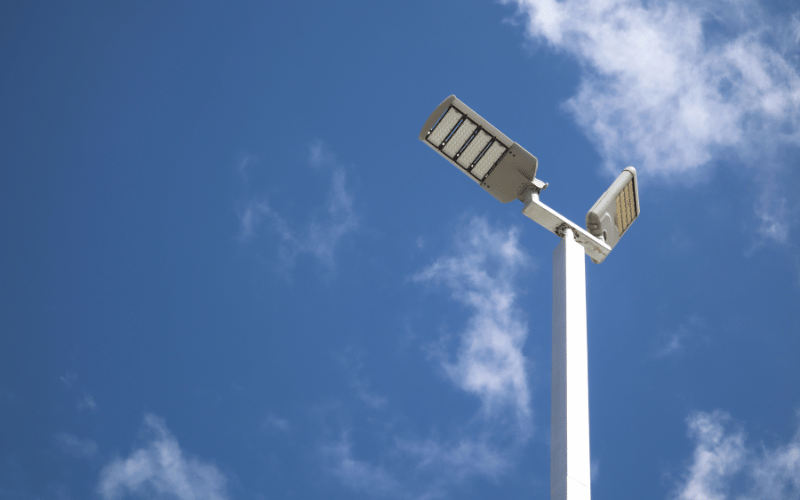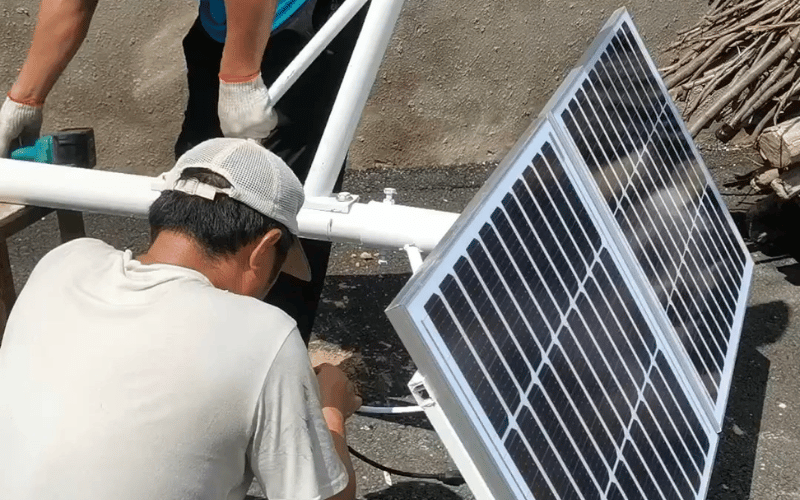Solar street lights are revolutionizing outdoor lighting by offering an eco-friendly and cost-effective alternative to traditional systems. Whether you’re lighting a small residential pathway or planning a large-scale urban project, understanding the costs and components involved is crucial. This guide provides a comprehensive breakdown of solar street light pricing, key factors influencing costs, and actionable insights to help you make an informed investment. From low-end models to high-end systems, and even large-scale installations, this article covers everything you need to know to choose the right solution for your needs.
Table of Contents
ToggleThe Price Range: What to Expect
Solar street lights come in a wide price range, typically starting from $100 for basic models and going up to $2,000 or more for high-end, feature-rich options. The cost depends on various factors, including performance, durability, and design. Below, we break down the key elements that influence pricing to help you understand what you’re paying for.
Factors Influencing Cost
-
Light Output (Lumens):
The brightness of a solar street light is measured in lumens. Entry-level models with 1,000–2,000 lumens are suitable for residential areas and cost around $100–$300. For commercial or public spaces requiring 5,000 lumens or more, expect to pay $500–$1,500. -
Battery Capacity:
High-capacity batteries, such as lithium-ion or LiFePO4, can store more energy, allowing the light to operate for longer hours. Basic models with smaller batteries may last 6–8 hours and cost less, while premium models with 12–15 hours of runtime can add $200–$500 to the price. -
Solar Panel Size:
Larger solar panels generate more power, enabling faster charging and better performance in low-sunlight conditions. A small panel (20–30W) is common in budget models, while larger panels (50–100W) in high-performance lights can increase costs by $300–$700. -
Pole Height and Material:
The height and material of the pole significantly impact the price. Aluminum or steel poles, which are durable and rust-resistant, are more expensive than basic iron poles. A 10-foot pole may cost $100–$200, while a 20-foot pole with premium materials can add $500 or more. -
Durability and Weatherproofing:
Lights designed to withstand extreme weather conditions, such as heavy rain, snow, or high temperatures, often come with IP65 or higher ratings. These features can increase the price by $100–$300 compared to standard models.
Average Cost Breakdown
Solar street light costs vary significantly depending on their features, durability, and intended use. Below is a detailed breakdown of what you can expect at different price points, along with real-world applications.
Low-End ($200–$400)
Basic solar street lights in this range are designed for minimal use, such as lighting small residential pathways or gardens. These models typically offer:
- Brightness: 1,000–2,000 lumens, suitable for low-traffic areas.
- Battery Life: 6–8 hours of operation, often using lead-acid batteries.
- Durability: Limited weatherproofing (IP44 or lower), making them less reliable in harsh conditions.
- Solar Panel Size: Small panels (10–20W), requiring full sunlight for optimal performance.
Example: A 1,500-lumen light with a 10-foot pole for a backyard or driveway.
Mid-Range ($500–$1,000)
Mid-range lights are the most popular choice for residential streets, parking lots, and small commercial areas. They typically include:
- Brightness: 3,000–5,000 lumens, providing adequate lighting for medium-traffic areas.
- Battery Life: 10–12 hours, often using lithium-ion batteries for better efficiency.
- Durability: Improved weatherproofing (IP65), making them suitable for outdoor use in most climates.
- Solar Panel Size: Medium panels (30–50W), ensuring faster charging even in moderate sunlight.
Example: A 4,000-lumen light with a 15-foot pole for a neighborhood street.
High-End/Heavy Duty ($1,500–$3,000+)
High-end systems are built for heavy-duty applications, such as highways, industrial zones, or public parks. These lights offer:
- Brightness: 8,000–12,000 lumens, ensuring high visibility in large or high-traffic areas.
- Battery Life: 15–20 hours, using advanced LiFePO4 batteries for extended lifespan.
- Durability: Superior weatherproofing (IP67 or higher) and corrosion-resistant materials like aluminum or galvanized steel.
- Solar Panel Size: Large panels (80–150W), capable of generating power even in low-light conditions.
Example: A 10,000-lumen light with a 20-foot pole for a highway or industrial complex.
Large Projects (Millions of Dollars)
For large-scale installations, such as city-wide street lighting projects, costs can escalate into the millions. Bulk purchases often reduce the per-unit cost, but additional expenses include:
- Custom Poles: Designed to match urban aesthetics, costing $1,000–$3,000 per pole.
- Installation: Labor and equipment for large-scale deployment can add $500–$1,000 per unit.
- Maintenance Contracts: Long-term maintenance agreements can cost $50,000–$100,000 annually for large projects.
Example: A city installing 1,000 high-end solar street lights for public roads, with a total project cost of $2–$3 million.
Key Components and Their Costs
Solar street lights are made up of several critical components, each playing a specific role in the system’s performance and durability. Below is a detailed breakdown of these components, their functions, and their typical price ranges.
1. Solar Panel
The solar panel is responsible for capturing sunlight and converting it into electricity to power the light.
- Cost Range: $50–$200+ per panel.
- Details: Smaller panels (20–50W) are used in basic models, while larger panels (100–150W) are required for high-performance systems. Monocrystalline panels, known for higher efficiency, are more expensive than polycrystalline ones.
- Example: A 100W monocrystalline panel for a commercial-grade light may cost around $150.
2. Battery
The battery stores the energy generated by the solar panel, ensuring the light operates during nighttime or cloudy days.
- Cost Range: $30–$150+ depending on capacity and type.
- Details: Lithium-ion batteries are the most common due to their long lifespan (3–5 years) and efficiency. Higher-capacity batteries (e.g., 20Ah or more) are used in premium models, while smaller ones (10Ah) are found in budget options.
- Example: A 12V 20Ah lithium-ion battery for a mid-range light costs approximately $100.
3. LED Light Fixture
The LED fixture is the actual light source, known for its energy efficiency and long lifespan.
- Cost Range: $40–$150+ depending on brightness and features.
- Details: Brightness is measured in lumens, with basic models offering 1,000–2,000 lumens and high-end fixtures exceeding 10,000 lumens. Additional features like motion sensors or adjustable brightness can increase costs.
- Example: A 5,000-lumen LED fixture with motion detection costs around $120.
4. Charge Controller
The charge controller regulates the flow of electricity from the solar panel to the battery, preventing overcharging and ensuring efficient energy use.
- Cost Range: $10–$50 depending on complexity.
- Details: Basic controllers are sufficient for small systems, while advanced models with MPPT (Maximum Power Point Tracking) technology improve efficiency and are used in high-end systems.
- Example: A 12V MPPT charge controller for a commercial light costs about $40.
5. Pole and Mounting Hardware
The pole and mounting hardware provide structural support for the light assembly, ensuring stability and proper positioning.
- Cost Range: $100–$300+ depending on height, material, and design.
- Details: Galvanized steel poles are common for their durability and rust resistance. Taller poles (15–20 feet) and decorative designs for urban areas can significantly increase costs.
- Example: A 20-foot galvanized steel pole for a highway light costs around $250.
Hidden Costs and Considerations
Beyond the initial purchase price, solar street lights come with additional costs and factors that can influence your overall budget. These hidden expenses are often overlooked but are crucial for a successful and long-lasting installation.
1. Installation
Professional installation is highly recommended to ensure safety and proper functionality.
- Cost Range: $100–$500+ per light.
- Details:
- For a basic setup, such as a 10-foot pole in a residential area, installation costs may be on the lower end, around $100–$200.
- Complex installations, like 20-foot poles in commercial or highway settings, can cost $400–$500+ per light due to the need for heavy equipment and specialized technicians.
- Additional costs may include trenching for underground wiring or securing the pole in areas with unstable soil.
2. Maintenance
While solar street lights require less maintenance than traditional systems, they still need periodic upkeep to ensure optimal performance.
- Cleaning Solar Panels: Dirt, dust, and debris can reduce efficiency by up to 20%. Cleaning every 6–12 months costs around $20–$50 per light if done professionally.
- Battery Replacement:
- Lithium-ion batteries typically last 5–7 years, while LiFePO4 batteries can last up to 10 years.
- Replacement costs range from $50 for small residential lights to $200+ for high-capacity batteries in commercial systems.
- LED Fixture Replacement: Although rare, LED fixtures may need replacement after 10–15 years, costing $100–$300 depending on brightness and features.
3. Permits and Regulations
Local regulations may require permits for installing solar street lights, especially in public or commercial spaces.
- Permit Fees: These can range from $50 to $200 per light, depending on your location and the complexity of the project.
- Details:
- Urban areas may have stricter zoning laws, requiring additional documentation or inspections.
- Some municipalities may also charge recurring fees for using public land or maintaining compliance with local safety standards.
Expert Insights and Real-World Examples
Solar streetlights are not just an eco-friendly solution but also a cost-effective investment. Below, we explore expert opinions, real-world case studies, and actionable tips to guide your decision-making process.
What Experts Say
- “Investing in solar streetlights offers significant long-term savings on energy bills and maintenance.” – Renewable Energy Analyst
- Explanation: Solar streetlights eliminate electricity costs entirely, making them a sustainable option for municipalities and businesses.
- “The initial cost is higher, but the payback period is often surprisingly short due to zero electricity usage.” – Urban Planning Consultant
- Explanation: While upfront costs may seem steep, the savings on energy and reduced maintenance often recover the investment within a few years.
Case Study: City of Springfield
- Project Overview: The city installed 500 solar streetlights across major roads and public spaces.
- Initial Investment: $750,000, including installation and materials.
- Annual Savings: Over $60,000 in electricity costs, thanks to the elimination of grid power usage.
- Payback Period: Under 13 years, after which the city benefits from free lighting.
- Additional Benefits: Reduced carbon footprint and improved public safety due to consistent lighting.
Case Study: Greenfield Community Park
- Project Overview: A small community park installed 10 solar streetlights to enhance safety and usability.
- Total Cost: $6,000, including installation.
- Benefits:
- Improved safety for visitors during evening hours.
- Extended park operating hours, increasing community engagement.
- Zero ongoing electricity bills, saving approximately $1,000 annually.
Making the Smart Investment: Actionable Tips
Assess Your Needs
Start by identifying the specific requirements for your solar street lights. Determine the brightness, measured in lumens, based on the area you want to illuminate. For example, residential streets typically need around 3,000 lumens per light, while highways or large public spaces may require 10,000 lumens or more. Additionally, evaluate the size of the area to ensure the lights provide adequate coverage.
Get Multiple Quotes
Gather quotes from at least three suppliers to compare costs, features, and warranties. For instance, one supplier might offer a 10-year warranty, while another provides only 5 years. Request detailed breakdowns of installation and maintenance costs to avoid unexpected expenses and ensure you’re getting the best value for your investment.
Consider the Total Cost
When budgeting, factor in the total cost of ownership. Installation costs can range from $100 to $500 per light, depending on the complexity of the setup. Maintenance expenses should also be considered, such as battery replacements every 5–10 years, which can cost $50–$200, and annual cleaning of solar panels, typically costing $20–$50 per light.
Look for Warranties
Choose products with robust warranties to ensure long-term reliability. Look for warranties that cover at least 5 years for the light fixture and 10 years or more for the solar panel. A strong warranty can save you from unexpected repair or replacement costs, providing peace of mind for your investment.
Check for Rebates
Research government programs or local incentives to reduce upfront costs. For example, some municipalities offer rebates that cover up to 30% of the total project cost. Contact your local energy department or utility company to explore available programs and take advantage of these savings opportunities.
Buy in Bulk
If you’re planning a large-scale project, consider buying in bulk to negotiate discounts with suppliers. For instance, purchasing 100 lights might reduce the per-unit cost by 10–20%. Bulk purchases often come with additional perks, such as extended warranties or free installation services, making them a cost-effective option for larger installations.
By following these actionable tips, you can make a smart investment that balances cost, performance, and long-term savings.
Frequently Asked Questions
Q: How much does a solar street light cost?
A: Solar street lights typically cost between $100 and $2,000 or more per unit. The price depends on factors like brightness (lumens), battery capacity, solar panel size, pole height, and weatherproofing. Basic models for residential use are on the lower end, while high-end systems for highways or industrial zones are more expensive.
Q: What factors influence the cost of solar street lights?
A: Several factors affect the cost, including:
- Light Output (Lumens): Higher brightness increases the price.
- Battery Capacity: Larger batteries for longer runtime cost more.
- Solar Panel Size: Bigger panels with higher efficiency add to the cost.
- Pole Material and Height: Durable materials like galvanized steel and taller poles are pricier.
- Weatherproofing: Features like IP65 or higher ratings for extreme weather durability increase costs.
Q: Are solar street lights worth the investment?
A: Yes, solar street lights are a smart investment. While the upfront cost may be higher than traditional lights, they eliminate electricity bills and require less maintenance. Over time, the savings on energy and reduced upkeep make them cost-effective and environmentally friendly.
Q: How long do solar street lights last?
A: Solar street lights can last 10–15 years with proper maintenance. The LED light fixtures typically last up to 50,000 hours, while lithium-ion or LiFePO4 batteries need replacement every 5–10 years. Regular cleaning of solar panels and timely battery replacements ensure optimal performance.
Q: What are the hidden costs of solar street lights?
A: Hidden costs include:
- Installation: Professional installation can cost $100–$500+ per light.
- Maintenance: Cleaning solar panels and replacing batteries or LED fixtures adds to long-term costs.
- Permits: Local regulations may require permits, costing $50–$200 per light.
Q: Can I get rebates or incentives for solar street lights?
A: Yes, many governments and local authorities offer rebates or incentives for solar installations. These can reduce upfront costs by up to 30%. Check with your local municipality or energy department for available programs.
Q: How do I choose the right solar street light?
A: To choose the right solar street light:
- Assess your lighting needs, including brightness and coverage area.
- Compare quotes from multiple suppliers.
- Factor in total costs, including installation and maintenance.
- Look for warranties covering at least 5 years for lights and 10 years for solar panels.
- Check for rebates or bulk discounts if purchasing for large projects.
Q: Do solar street lights work in low-sunlight areas?
A: Yes, solar street lights can work in low-sunlight areas if equipped with larger, high-efficiency solar panels and high-capacity batteries. These features ensure sufficient energy storage for nighttime operation, even in less sunny conditions.
Q: What maintenance do solar street lights require?
A: Maintenance includes:
- Cleaning solar panels every 6–12 months to remove dirt and debris.
- Replacing batteries every 5–10 years, depending on the type.
- Inspecting and replacing LED fixtures after 10–15 years if needed.
- Checking the charge controller and wiring periodically for any issues.
Conclusion: A Bright Future for Your Wallet and the Planet
Solar street lights are a worthwhile investment that combines sustainability with long-term savings. With prices ranging from a few hundred to several thousand dollars per unit, they cater to a variety of needs and budgets. By understanding the factors influencing costs, hidden expenses, and expert insights, you can make informed decisions that ensure reliable lighting and significant cost benefits for years to come. Choose wisely to illuminate your spaces while contributing to a brighter, greener future.




